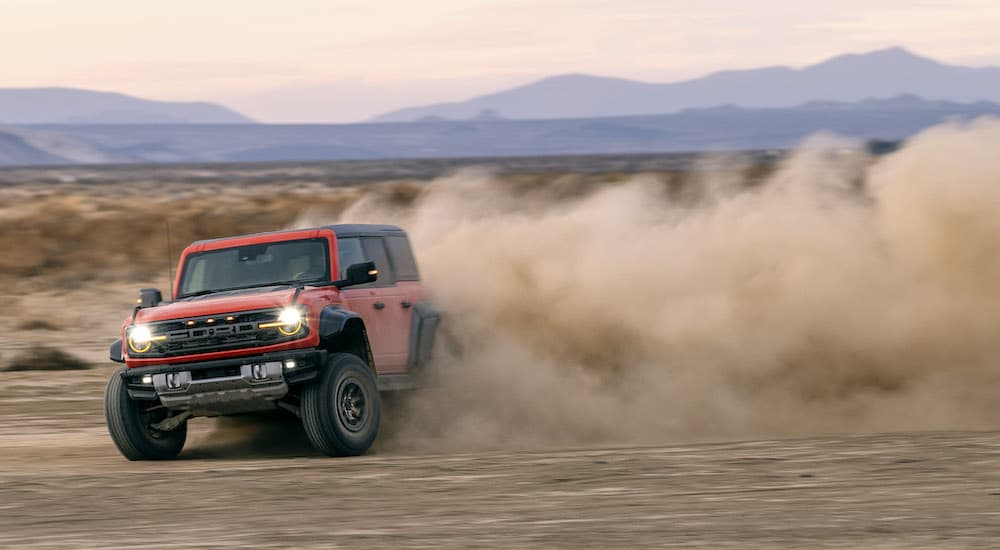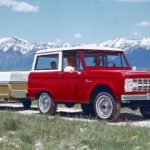What does “GOAT” mean to you? For some, it’s a cloven-hoofed ruminant that makes cheese and eats trash. For others, it means “the Greatest Of All Time.” For those of us dreaming of finding the legendary Ford Bronco for sale, it means “Goes Over Any [Type of] Terrain.” But is there really a difference? (Between the latter two, that is.)
The Bronco is one of the greatest SUVs of all time. Ford was determined to make it as much in the early 1960s when the Jeep craze was well underway—but Ford was quietly working to turn the tides. The automaker tasked a team with surveying Jeep owners to determine what they loved and hated about their models. The feedback was clear: the Jeep lacked any basic comforts, offered a terrible ride, was noisy, and was prone to vibrations. So Ford set out to do better, citing as much in a 1963 memo that outlined plans for the “1966 GOAT.”
The 1960s Bronco embodied Ford’s vision to build a “Goes Over All Terrain” vehicle, but it also became the Greatest Of All Time in the realm of iconic SUVs. The modern Bronco builds on that legacy, paying homage to its history by offering its GOAT Modes, yet again proving its capacity to tackle every type of terrain without breaking a sweat. But beyond the catchy acronym, what are these modes? What level of performance do they offer that distinguishes the Bronco as the “Greatest Of All Time?”
Have You Ever Seen a Goat?
Goats are funny creatures, bounding across the terrain and defying gravity as if they have a hidden set of wings or springs in their hooves. It’s an agility I’ve witnessed firsthand as neighborhood goats have busted through privacy fences to satiate their need to explore; another somehow managed to climb a tree, bleating like a crying child until someone helped it down. Their surefootedness makes them incredibly agile—even the fainting goats that ignite a fury of giggles.
A goat’s agility is a characteristic easily attributed to the Ford Bronco, and the shared name is no coincidence. It’s another layer of the proverbial onion that exposes the adventurous heart of this Ford icon.
While the Bronco’s GOAT Modes pay homage to its history, they also immediately draw to mind the goat itself. Its bounding nature gives the Bronco a distinct appeal. It’s a large SUV, but even so, it’s agile and powerful to navigate the most technical terrain. It’s surefooted in every scenario, having its own version of a spring in its step.
The Bronco’s GOAT Modes unite this imagery with the ability to give you more control over how this SUV performs and handles various conditions. Whereas other off-road rigs limit your control beyond 4HI and 4LO, Ford goes legions beyond to let you finetune the very components that make the Bronco a road warrior thirsty for adventure. It’s a g(r)as(s)-guzzling goat of the best kind.
The GOAT Modes (Capra hircus Not Included)
The Bronco rolls off the production line with an industry-leading Terrain Management System, equipping the entire lineup with GOAT Modes. Trims like the Big Bend, Outer Banks, and Heritage have six drive modes that reflect their versatility. Still, Ford distinguishes top-tier trims like the Badlands, Wildtrak, Raptor, and Heritage Limited by extending the suite with Rock Crawl and Baja. Their addition encourages you to push the Bronco to its limits. But why is there a need for so many modes, and how do they differentiate themselves when you’re behind the wheel?
Normal: The Weekday Mode
Unless you’ve been to the Bronco Off-Roadeo (yes, it’s a thing) to learn the intricacies of your Ford Bronco, there’s a learning curve to the drive modes and what they do. Fortunately, the Bronco’s GOAT Modes start with a suite of pavement-oriented modes like Normal. It’s the Bronco’s default mode when you start the ignition and it gives you access to the four-wheel drive modes and any hero buttons (an option when you add the Off-Road Hero Switch Pack).
Think of Normal Mode as your everyday standard. Since its default is 2WD High, it’s perfect for navigating your commute, running errands around town, and managing your drive to the trailhead. More importantly, Normal Mode still lets you tailor the Bronco’s features to your needs. For example, you can use the hero switches to engage the hazard lights if you need to pull off the side of the road or stop for an emergency. You can also engage the Electronic Stability Control when conditions become slippery, as roads are prone to do amid heavy rain and sleet. When traveling below 24 mph, you can even lock the rear differential or switch into 4L and lock the front differential.
Eco: The Fuel-Saving Mode
The Bronco’s incredible versatility means it’s at home on the pavement as much as on the trail. Ford heightens that versatility by adding Eco Mode, ideal for in-town driving. In Eco Mode, the Bronco minimizes fuel consumption by softening the throttle response and disabling off-road and performance-oriented features like the locking differentials. Its goal is to conserve fuel, and it does an outstanding job at this.
Sport: The Kick-It-Up-a-Notch Mode
Where Eco Mode conserves fuel by toning down the Bronco’s performance, Sport Mode does the opposite without dramatically compromising its efficiency. Instead of turning off most features, Sport Mode finetunes those needed to improve the Bronco’s responsiveness and handling. For example, it increases the response of the accelerator pedal and tightens the steering so the Bronco handles more like a sports car. With longer time spent in lower gears, acceleration is faster, making the Bronco a thrill to drive on winding backroads and straightaways.
Slippery: The Slip-N-Don’t-Slide Mode
The Bronco is a lifestyle vehicle, meaning it’s not solely destined for the trail or limited to certain seasons as would a summer performance car. Instead, it’s built as an all-around performer, reliable for handling every condition, from summer days to spring downpours and winter snowstorms. Slippery Mode reflects as much, immediately putting the Bronco in 4WD Auto, lowering its throttle response, and tuning the shift patterns to handle rain, ice, and other slippery conditions. By defaulting to 4A or 4H, Slippery Mode optimizes traction and does everything within its power to minimize wheel slip to keep you in control.
Sand/Snow: The Soft Terrain Mode
While the Bronco is destined to get mud on its tires, it’s also at home on soft or loose terrain, like sand, snow, and gravel. In many cases, you already know you’re headed to the dunes or down a gravel road and can prepare by airing down the tires for better traction and handling. Then, when you switch into Sand/Snow Mode, the Bronco automatically defaults to 4WD High, locks the rear differential, and increases traction control. By keeping the Bronco in a lower gear longer, heightening the brakes, and adjusting the steering, you have more momentum and control as you navigate the terrain. Moreover, when traveling at speeds under 15 mph, Sand/Snow Mode automatically engages the front trail camera to improve your visibility ahead of the Bronco.
Mud/Ruts: The In-the-Trenches Mode
Like Sand/Snow Mode, Mud/Ruts automatically switches the Bronco into 4WD High but turns the traction control off. Once in this mode, the Bronco’s rear differential locks and the brakes are enhanced, giving you more control over the Bronco and making it easier to correct as you navigate muddy conditions. In doing so, the Bronco has the low-end power and capability to maintain its momentum and pull itself out of deep mud or ruts. You also have the option to further enhance the Bronco’s traction by locking the front differential using the hero switches.
Rock Crawl: The Slow-N-Steady Mode
Rock Crawl differentiates itself as the most rugged of the Bronco’s GOAT Modes because it’s the only one to default to 4WD LO. It gives new meaning to the heavy-duty hauler’s phrase, “Put it in ‘granny’—LO and GO!” As the name implies, it’s ideal for rock crawling and surmounting obstacles because it adjusts the shift pattern, tightens the steering, softens the accelerator, and tunes the brakes. The dampened accelerator limits your speed, while the brakes are more responsive to help you maintain control. This combination heightens the Bronco’s agility as it tackles the most exciting and demanding terrain.
Baja: The Sport-Mode for the Trail
The Bronco‘s full suite of GOAT Modes concludes with the most fun, Baja. Likened to an off-road Sport Mode, Baja lets you unleash the Bronco’s full potential on the trail. Baja Mode heightens the response of the throttle and increases the torque output for pure thrills along the dirt road. The only caveat is that Baja Mode is best enjoyed on loose terrain where kicking up dirt and sand is expected.
The Greatest Of All Time
The Bronco is an icon because of its rich history in the Ford lineup, but it’s also proven its chops as one of the most well-rounded SUVs ever made. Just as important, it puts veteran trail runners like the Jeep Wrangler on notice and challenges its rivals to do more and be better.
This is pronounced in the Bronco’s GOAT Modes, which celebrate that heritage and embody the many personalities of the surefooted Bronco. It’s a stellar combination of terrain-tailored capabilities that undeniably makes the Bronco the “Greatest Of All Time.”






